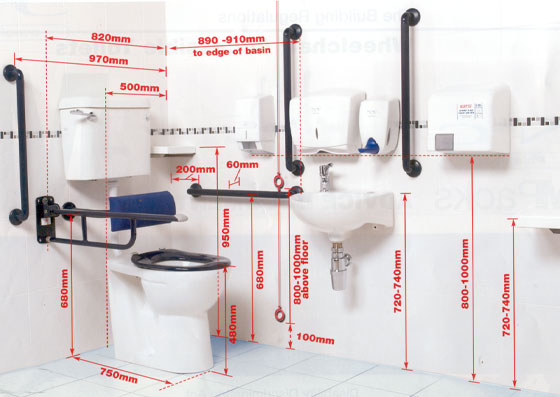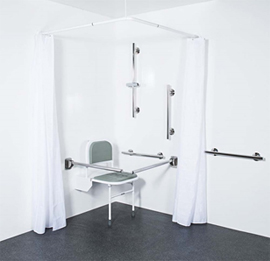
UK's No.1 Mobility Shop
Highlighting Parts of Document M

Sanitary Accommodation
Page 52 -
5.1 In Principle, suitable sanitary accommodation should be available to everybody, including sanitary accommodation designed for wheelchair users, ambulant disabled people, people of either sex with babies and small children or people encumbered by luggage.
5.2 In multi- storey buildings, the consistent location of toilets on each floor can help people with learning difficulties to locate these facilities easily.
5.3 A number of issues needs to be considered in connection with all forms of sanitary accommodation. These relate to needs of people with visual or hearing impairments, people with learning difficulities and people whose lack of tactile sensitivity can cause them to be injured by touching hot surfaces. Taps and WC cubicle dooors should be operable by people with limited strength or manual dexterity and doors to cubicles should be capable of being opened if a person has collapsed against them while inside the cubicle. Preferably, all doors to WC cubicles and wheelchair- accessible unisex toilets open out or, if they open in, the door swing should not encroach into the wheelchair turning space or minimum activity space. Where possible, light switches with large push pads should be used in preference to pull cords.
Provisions
5.4 Sanitary accommodation will satisfy Requirement M1 or M3 if:
a. any bath or wash basin tap is either controlled automatically, or is capable of being operated using a closed fist, e.g. by lever access;
b. terminal fittings comply with Guidence Note G18.5 of the Guidence Document relating to schedule 2:
Requirments for water fittings, of the water supply (water fittings) Regulations 1999, Sl 1999/ 1148;
c. door handles and other ironmongery comply with provisions 3.10 (d) and (e) of 'Internal doors';
d. Wc compartment doors, and doors to wheelchair -accessible unisex toilets, changing rooms or shower rooms are fitted with light action privacy bolts so that they can be operated by people with limited dexterity and, if required to self -close, can be opened using a force no greater than 20N;
e. Wc compartment doors, and doors to wheelchair -accessible unisex toilets, changing rooms or shower rooms have an emergency release mechanism so that they are capable of being opened outwards, from the outside, in case of emergency;
f. doors, when open, do not obstruct emergency escape routes;
g. any fire alarm emits a visual and audible signal to warn occupants with visual and hearing impairments.
h. any emergency assistance alarm system has
i) visual and audible indicators to confirm that an emergancy call has been recieved;
ii) a reset control reachable from a wheelchair and the WC, or from the wheelchair and shower/changing seat;
iii) a signal that is distinguishable visually and audibly from the fire alarm.
Page 53
Provision of toilet accomodation
Design Considerations
5.5 Toilet accommodation needs to be suitable, not only for disabled people, but for all people who use the building. For disable people, suitable toilet accommodation may take the form of a specially designed cubicle in seperate - sex toilet washrooms , or a self- contained
unisex toilet. For wheelchair users in particular, a self contained unisex toilet is always preffered option since, if necessary a partner or carer of a different sex can enter to give assistance. Wheelchair- accessable unisex toilets should always be provided in addition to any wheelchair accessible accommodation in seperate sex toilet washrooms. Wheelchair accessible unisex toilets should not be used for baby changing.
5.6 The provision of an enlarged cubicle in a separate - sex toilet washroom can be of benefit to ambulant disabled people, as well as parents with children, and people (e.g those with luggage) who need enlarged space. In large building developments, seperate facilities for baby changing units and an adult changing table are desirable.
Note: For specific guidence on the provision of sanitary accomodation in sports buildings, refer to 'Access for Disabled People'.
Provisions
5.7 The provision of toilet accommodation will satisfy Requirement M1 or M3 if:
a. where there is space for only one toilet in a building, it is of a wheelchair accessible unisex type, but of greater width to accommodate a standing height wash basin;
b. at least one wheelchair -accessible unisex toilet is provided at the location in a building where sanitary facilities are provided for use by customers and visitors to a building, or by people working in the building;
c. at least one WC cubicle is provided in seperate - sex toilet accommodation for use by ambulant disable people;
d. where there are 4 or more WC cubicles in seperate - sex toilet accommodation, one of these is an enlarged cubicle for use by people who need extra space, im addition to any provision under 5.7 (c)
Design Considerations
5.8 Wheelchair users should not be able to approach, transfer to, and use the sanitary facilities provided within a building. This requires the provision of a wheelchair - accessible unisex toilet. The relationship of the WC to the finger rinse basin and other accessories should allow a person to wash and dry hands while seated on the WC. The space provided manoeuvring, should enable wheelchair users to adopt various transfer techniques that allow independent or assisted use. It is important that the transfer space alongside the WC is kept clear to the back wall. When transferring to and from their wheelchair, some people need horizontal support rails. The rail on the open side is a drop-down rail, but on the wall side, it can be a wall mounted grab rail (which is thought to give more rigid handhold) set at greater distance than normal from the wall or alternatively, a second dropdown rail in addition to the wall mounted grab rail where the grab rail is spaced at the minimum distance from the wall and therefore does not give the same degree of support.
